Global market for cryptocurrency Forecast
- Global market for cryptocurrency valuation likely to see a robust rise at a CAGR of 11.4% over 2023 - 2030
- Market size poised to reach US$9.8 Bn by 2030, up from US$4.1 Bn attained in 2022
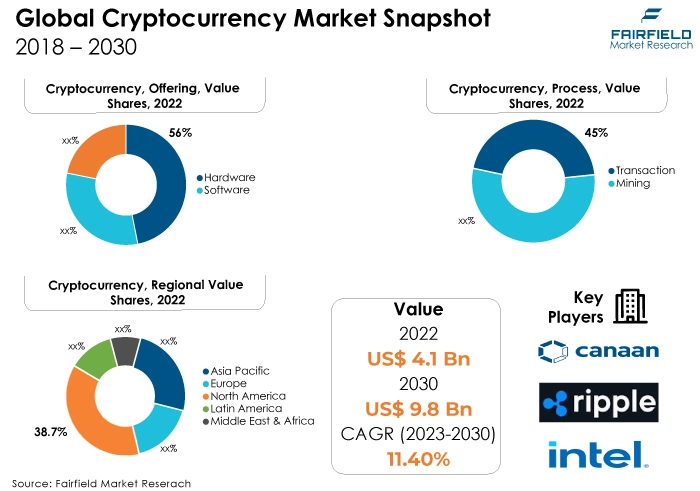
Quick Report Digest
- The key trend anticipated to fuel the cryptocurrency growth is a growth in the popularity of investing among youths. It is due to their potential for high returns, ease of digital transactions, and perceived technological innovation.
- Another major market trend expected to fuel the market for cryptocurrency growth is the rising use of digital currency. The distributive nature of cryptocurrencies, coupled with their potential for financial innovation and security, has led to their rising popularity as an alternative to traditional fiat currencies.
- Despite the fact that Bitcoin uses cutting-edge financial technology, the absence of laws and a single accepted method for exchanging digital money is predicted to limit its expansion. The use of cryptocurrencies for illegal reasons worries regulators from all over the world, which poses a substantial obstacle to the market's growth.
- In 2022, the hardware category dominated the industry. It encompasses the physical components and devices used in cryptocurrency transactions and mining, which includes cryptocurrency wallets, which store digital assets securely offline or online.
- In terms of market share for cryptocurrency globally, the mining segment is anticipated to dominate. It involves solving complex mathematical puzzles using computational power to add new transactions to a blockchain.
- In 2022, the Bitcoin category controlled the market. Bitcoin operates on a decentralised ledger technology called blockchain, offering security and transparency.
- The North American region is anticipated to account for the largest share of the global market for cryptocurrency, owing to various factors such as fostering innovation, robust regulatory framework and investor confidence.
- The cryptocurrency market is expanding in Asia Pacific due to the region's large population, growth in the middle-class population, and use of digital currencies and blockchain technologies. The region’s vibrant fintech ecosystem supports cryptocurrency exchanges and start-ups.
A Look Back and a Look Forward - Comparative Analysis
The market for cryptocurrency has gained popularity as a result of factors such as regulatory developments and institutional interest. Prices experienced fluctuations, and adoption continued to grow, with discussions around blockchain technology's potential.
The market witnessed staggered growth during the historical period 2018 – 2022. It is due to the rapid price fluctuations and regulatory challenges. Nevertheless, it has attracted substantial investments and innovations, with thousands of cryptocurrencies introduced. Bitcoin remained the dominant player but Ethereum and other altcoins had also gained prominence. The market's evolution and regulatory landscape may have continued to evolve since then.
With the increasing acceptance and adoption, it is anticipated to mature into a mainstream financial ecosystem. Regulatory clarity will play a pivotal role in shaping its trajectory, balancing innovation with investor protection. Many cryptocurrencies like Bitcoin and Ethereum will continue to influence market trends, while newer projects will emerge, diversifying the market further.
As traditional financial institutions integrate blockchain technology, cryptocurrencies' legitimacy as an asset class will strengthen, potentially leading to widespread use for payments, investments, and beyond.
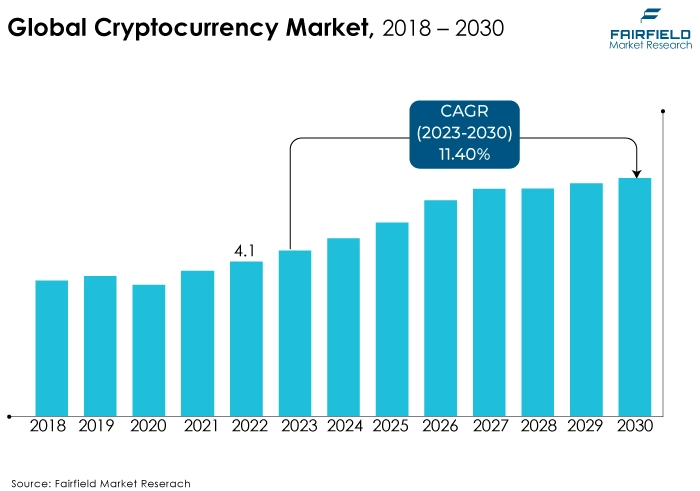
Key Growth Determinants
- Increasing Adoption by Institutional Investors
Institutions and even traditional banks are increasingly entering the crypto space due to several reasons. The growing infrastructure and regulatory clarity in many countries make it easier for institutions to participate in the market. They can now access cryptocurrency through regulated exchanges and custody services, reducing concerns about security, and compliance.
The potential for more returns in the crypto market is attractive to institutions seeking alpha in their portfolios. As more institutional capital flows into cryptocurrencies, it adds legitimacy to the asset class, encourages further investment, and ultimately drives up demand and market liquidity. The institutional adoption brings stability, liquidity, and increased mainstream acceptance to the market for cryptocurrency.
- Swift Advances in Blockchain Technology
The blockchain technology provides enhanced security. It employs cryptographic techniques to secure transactions, making it complicated for malicious actors to alter or hack into the system. This heightened security has attracted investors and institutions to participate in the market for cryptocurrency, increasing its overall liquidity, and credibility. Traditional financial systems often involve intermediaries and lengthy settlement processes, incurring high fees and delays.
Blockchain eliminates these intermediaries, enabling real-time, low-cost international transactions, which is especially appealing for global businesses and individuals. As these innovations continue to evolve, they will further drive adoption and expansion in the global market for cryptocurrency, making it a prominent fixture in the future of finance and technology.
- Normalisation of Online Payment
In recent years, the world has witnessed a substantial shift towards digital transactions, thanks to the convenience and accessibility offered by online payment systems. Traditional financial institutions, such as banks, have faced increasing competition from fintech companies, and this has accelerated the adoption of digital payment methods.
Cryptocurrencies provide several advantages over traditional payment methods, including faster cross-border transactions, reduced transaction fees, and enhanced security through blockchain technology.
As individuals and businesses continue to recognise the benefits of online payments and cryptocurrencies, the global cryptocurrency market is poised for further growth, making it a key driver in the evolving landscape of financial transactions.
Major Growth Barriers
- Lack of Regulatory Standardisation
Governments worldwide are battling with how to classify and regulate cryptocurrencies, leading to a need for clear guidelines. This ambiguity hampers investor confidence and adoption, as market participants still need to learn about potential legal restrictions, taxation, and compliance requirements, which can impede the growth and stability of the market for cryptocurrency.
- Increasing Misuse of Virtual Currency
Unlawful activities such as money laundering, tax evasion, and illegal transactions thrive in the decentralised nature of cryptocurrencies. This misuse poses regulatory challenges and undermines the trust and credibility of the entire digital asset ecosystem.
Governments and financial institutions worldwide are battling with the need for robust measures to combat illicit activities, creating a critical hurdle for the market for cryptocurrency's mainstream adoption.
Key Trends and Opportunities to Look at
- Growing Popularity Among Young Demographics
Younger generations are increasingly drawn to cryptocurrencies due to their potential for high returns, ease of digital transactions, and perceived technological innovation. The allure of digital assets as an alternative investment class is propelling the growth of the cryptocurrency market as it seeks to engage with the future of finance.
- High-security Data Processing
Cryptocurrencies utilise advanced encryption techniques and blockchain technology to ensure the secure storage and transmission of digital assets. This enhanced security instills confidence among users, reducing the risk of theft or fraud. As a result, more individuals and institutions are entering the cryptocurrency space, driving its expansion and adoption in the financial ecosystem.
- Rising Use of Digital Currency
As people recognise the benefits of cryptocurrencies, such as Bitcoin, and Ethereum, they are embracing them for various purposes, including online transactions, investments, and remittances. The distributive nature of cryptocurrencies, coupled with their potential for financial innovation and security, has led to their rising popularity as an alternative to traditional fiat currencies.
Additionally, the growing acceptance of cryptocurrencies by businesses and financial institutions is further fueling their use, making them a prominent force in the modern financial landscape.
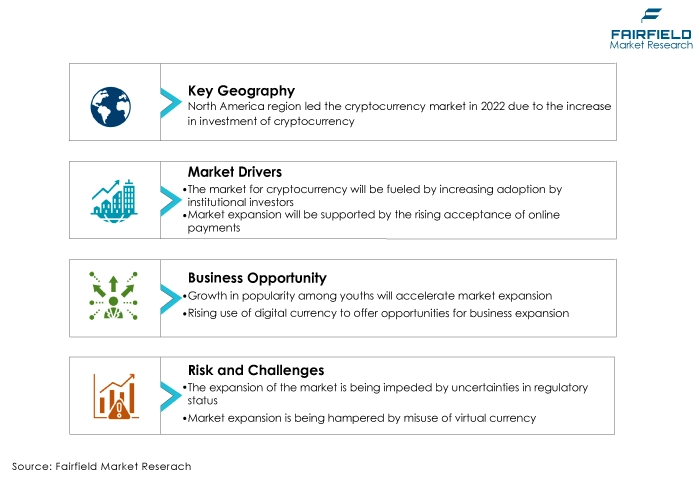
How Does the Regulatory Scenario Shape this Industry?
Over the last three years, regulatory bodies tasked with overseeing digital currencies aim to strike a balance between fostering innovation and safeguarding investors and the financial system. In the United States, the Securities and Exchange Commission (SEC) has taken steps to classify certain cryptocurrencies as securities, subjecting them to strict regulations.
The Commodity Futures Trading Commission (CFTC) also oversees cryptocurrency derivatives markets, ensuring fair trading practices. In Europe, the European Securities and Markets Authority (ESMA) and the European Central Bank (ECB) have issued guidelines and warnings regarding the risks associated with cryptocurrencies.
In Asia, regulatory bodies like the People's Bank of China (PBOC) have banned cryptocurrency trading and initial coin offerings (ICOs) to maintain financial stability. The global market for cryptocurrency's future growth and stability depend on a delicate interplay between innovation and regulatory oversight.
As these regulatory bodies continue to evolve their approaches, the cryptocurrency industry must adapt to ensure its long-term viability and legitimacy in the global financial landscape.s
Fairfield’s Ranking Board
Top Segments
- Hardware Category Maintains Dominance
The hardware segment dominated the market in 2022. It encompasses the physical components and devices used in cryptocurrency transactions and mining, which includes cryptocurrency wallets, which store digital assets securely offline or online.
Additionally, specialised mining hardware like application-specific integrated circuit (ASIC) devices play a crucial role in the process of showing and recording transactions on blockchain networks like Bitcoin.
Furthermore, the software category is projected to experience the fastest market growth. It encompasses the digital tools and applications used to manage, trade, and utilise cryptocurrencies, which include cryptocurrency exchange platforms, digital wallets (software counterparts to hardware wallets), and blockchain development platforms. These software solutions facilitate the buying, selling, and transacting of cryptocurrencies and provide essential functionalities for blockchain development.
- Mining Industry Leads the Way
In 2022, the mining category dominated the industry. It involves solving complex mathematical puzzles using computational power to add new transactions to a blockchain. Miners are rewarded with newly created coins and transaction fees for their efforts.
The transaction category is anticipated to grow substantially throughout the projected period. It involves the exchange of digital assets from one party to another, recorded on a decentralised ledger, ensuring transparency and security. The efficiency, speed, and cost of transactions vary between different cryptocurrencies, with some focusing on improving scalability and reducing fees.
- Bitcoin Spearheads, Ethereum Expects the Fastest Growth
The Bitcoin segment dominated the market in 2022. It is often considered a store of value and digital gold. Bitcoin operates on a decentralised ledger technology called blockchain, offering security and transparency. It is primarily used as a digital asset for investment and transactions.
The Ethereum category is expected to experience the fastest growth within the forecast time frame. It introduced the concept of smart contracts, enabling developers to build distributive applications on its platform.
Ether is its native Cryptocurrency and is used to power these applications. Ethereum's versatility has made it a popular choice for various blockchain-based projects, from decentralised finance to non-fungible tokens.
Regional Frontrunners
Led by the US, North America Secures the Top Spot
In the technology industry, cryptocurrency adoption is anticipated to dominate in the North American region. The robust regulatory framework, fostering innovation and investor confidence are the factors driving the market growth. The US, in particular, is home to numerous cryptocurrency exchanges, startups, and blockchain technology companies.
North American institutions are increasingly investing in cryptocurrencies while retail adoption continues to grow. However, regulatory clarity remains a key challenge, with ongoing discussions around the classification and taxation of cryptocurrencies. Overall, North America's market for cryptocurrency continues to evolve, driven by innovation and a growing interest in digital assets.
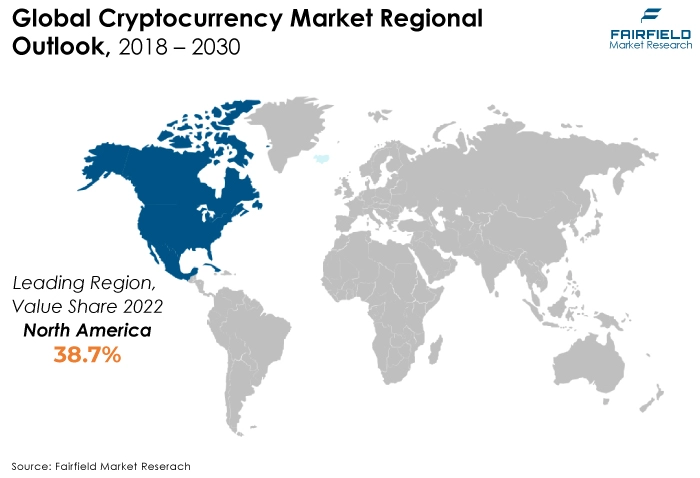
Vibrantly Growing Fintech Sector Raises Attractiveness of Asia Pacific
The increase in adoption and innovation by the countries is driving expansion in the Asia Pacific cryptocurrency market. The large population and growing middle class offer a significant user base for digital currencies and blockchain applications. China's active involvement in blockchain technology, despite occasional regulatory crackdowns, continues to shape the market. Furthermore, the region's vibrant fintech ecosystem supports cryptocurrency exchanges and startups.
Asia Pacific is poised for continued growth in the cryptocurrency market due to a combination of regulatory support, technological innovation, and increasing consumer interest. However, regulatory changes, and geopolitical factors can also influence the market's trajectory in the region.
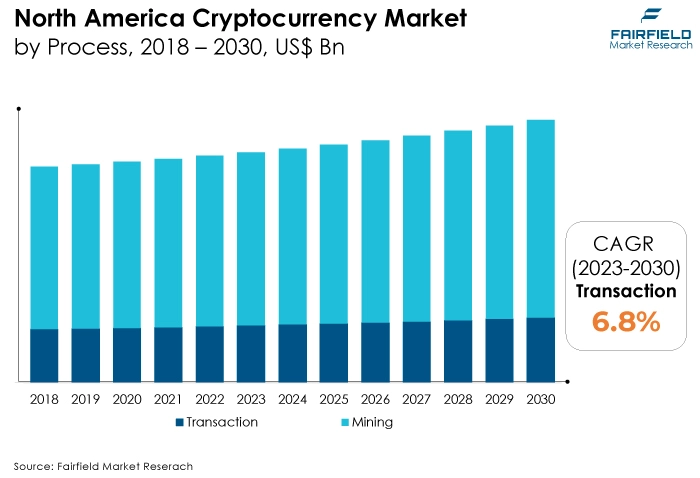
Fairfield’s Competitive Landscape Analysis
The global cryptocurrency market is a strengthening market with fewer major players present across the globe. The key players are focusing on technological advancements and regulatory developments to enhance their worldwide presence. Bitcoin, and Ethereum continue to dominate, with strong adoption and market capitalisation.
Who are the Leaders in the Global Cryptocurrency Space?
- Bitmain
- NVIDIA
- Intel
- Advanced Micro Devices
- Ripple Labs
- Ethereum Foundation
- Bitfury Group
- BitGo
- Coinbase
- Canaan Creative
- Binance Holdings
- Bitstamp
- Ifinex
- Ledger SAS
- Xapo
- Alcheminer
Key Company Developments
New Product Launches
- June 2021: NYDIG, a digital asset management firm, joined with NCR Corporation to make crypto purchases available to credit unions and 650 banks. It is to make consumer demand from NCR clients who have been buying digital money through third-party exchanges.
- March 2021: Visa Inc. developed crypto payments directly on Ethereum Blockchain and aims to get it as a new service payment. The company aims to accept cryptocurrencies as a payment method for the finance industry.
- February 2020: Canaan Inc., a China-based crypto mining manufacturer, joined with Northern Data AG, a blockchain infrastructure firm, to put together their technological and operational resources.
Distribution Agreements
- November 2021: Ripple joined with the Republic of Palau to explore the country's national digital currency and its uses with the XRP Ledger. It aimed to develop cross-border payments and USD-backed digital currency for Palau.
- January 2020: com acquired WazirX Bitcoin exchange based in Mumbai, India. With this acquisition, Binance.com is emphasizing on expanding its business portfolio in India. Binance.com patented the Fiat Gateway platform, and WazirX's peer-to-peer (P2P) engine will be integrated to facilitate the trading of the digital currency of Binance.com with the purchasing of Tether or USDT.
An Expert’s Eye
Demand and Future Growth
As per Fairfield’s Analysis, the growing interest in blockchain technology is driving the market. The increasing mainstream adoption and institutional investment are increasing the need for c
ryptocurrency. Additionally, the emergence of decentralised finance (DeFi), and non-fungible tokens (NFTs) is diversifying the market and attracting a broader range of investors. Overall, the cryptocurrency market is expected to remain a dynamic and promising sector with substantial growth potential.
Supply Side of the Market
According to our analysis, the United States is one of the major users and providers of technology in the cryptocurrency market due to the presence of numerous cryptocurrency exchanges, startups and blockchain technology companies.
For instance, In February 2022, Intel Corporation propounded to add to the development of blockchain technology with a roadmap of energy-efficient accelerators. It stated that its chip would ship later in the year. Argo Blockchain, Block & Grid Infrastructure is their first customer for this upcoming product.
Cryptocurrency producers are working on technologically advanced versions to increase production, accuracy, and adaptability. Countries such as China, and India are also the major innovators and adopters in the Asia Pacific region due to involvement in blockchain technology, regulatory support and an increase in consumer interest. However, regulatory changes and geopolitical factors can hinder the market growth globally.
The Global cryptocurrency market is Segmented as Below:
By Offering:
- Hardware
- Software
By Process:
- Mining
- Transaction
By Type:
- Bitcoin
- Ethereum
- Bitcoin Cash
- Ripple
- Litecoin
- Dash
By Geographic Coverage:
- North America
- U.S.
- Canada
- Europe
- Germany
- U.K.
- France
- Italy
- Turkey
- Russia
- Rest of Europe
- Asia Pacific
- China
- Japan
- South Korea
- India
- Southeast Asia
- Rest of Asia Pacific
- Latin America
- Brazil
- Mexico
- Argentina
- Rest of Latin America
- Middle East & Africa
- GCC
- South Africa
- Egypt
- Nigeria
- Rest of the Middle East & Africa
1. Executive Summary
1.1. Global Cryptocurrency Market Snapshot
1.2. Future Projections
1.3. Key Market Trends
1.4. Regional Snapshot, by Value, 2022
1.5. Analyst Recommendations
2. Market Overview
2.1. Market Definitions and Segmentations
2.2. Market Dynamics
2.2.1. Drivers
2.2.2. Restraints
2.2.3. Market Opportunities
2.3. Value Chain Analysis
2.4. Porter’s Five Forces Analysis
2.5. COVID-19 Impact Analysis
2.5.1. Supply
2.5.2. Demand
2.6. Impact of Ukraine-Russia Conflict
2.7. Economic Overview
2.7.1. World Economic Projections
2.8. PESTLE Analysis
3. Global Cryptocurrency Market Outlook, 2018 - 2030
3.1. Global Cryptocurrency Market Outlook, by Offering, Value (US$ Bn), 2018 - 2030
3.1.1. Key Highlights
3.1.1.1. Hardware
3.1.1.2. Software
3.2. Global Cryptocurrency Market Outlook, by Process, Value (US$ Bn), 2018 - 2030
3.2.1. Key Highlights
3.2.1.1. Mining
3.2.1.2. Transaction
3.3. Global Cryptocurrency Market Outlook, by Type, Value (US$ Bn), 2018 - 2030
3.3.1. Key Highlights
3.3.1.1. Bitcoin
3.3.1.2. Ethereum
3.3.1.3. Bitcoin Cash
3.3.1.4. Ripple
3.3.1.5. Litecoin
3.3.1.6. Dash
3.4. Global Cryptocurrency Market Outlook, by Region, Value (US$ Bn), 2018 - 2030
3.4.1. Key Highlights
3.4.1.1. North America
3.4.1.2. Europe
3.4.1.3. Asia Pacific
3.4.1.4. Latin America
3.4.1.5. Middle East & Africa
4. North America Cryptocurrency Market Outlook, 2018 - 2030
4.1. North America Cryptocurrency Market Outlook, by Offering, Value (US$ Bn), 2018 - 2030
4.1.1. Key Highlights
4.1.1.1. Hardware
4.1.1.2. Software
4.2. North America Cryptocurrency Market Outlook, by Process, Value (US$ Bn), 2018 - 2030
4.2.1. Key Highlights
4.2.1.1. Mining
4.2.1.2. Transaction
4.3. North America Cryptocurrency Market Outlook, by Type, Value (US$ Bn), 2018 - 2030
4.3.1. Key Highlights
4.3.1.1. Bitcoin
4.3.1.2. Ethereum
4.3.1.3. Bitcoin Cash
4.3.1.4. Ripple
4.3.1.5. Litecoin
4.3.1.6. Dash
4.3.2. BPS Analysis/Market Attractiveness Analysis
4.4. North America Cryptocurrency Market Outlook, by Country, Value (US$ Bn), 2018 - 2030
4.4.1. Key Highlights
4.4.1.1. U.S. Cryptocurrency Market by Offering, Value (US$ Bn), 2018 - 2030
4.4.1.2. U.S. Cryptocurrency Market Process, Value (US$ Bn), 2018 - 2030
4.4.1.3. U.S. Cryptocurrency Market Type, Value (US$ Bn), 2018 - 2030
4.4.1.4. Canada Cryptocurrency Market by Offering, Value (US$ Bn), 2018 - 2030
4.4.1.5. Canada Cryptocurrency Market Process, Value (US$ Bn), 2018 - 2030
4.4.1.6. Canada Cryptocurrency Market Type, Value (US$ Bn), 2018 - 2030
4.4.2. BPS Analysis/Market Attractiveness Analysis
5. Europe Cryptocurrency Market Outlook, 2018 - 2030
5.1. Europe Cryptocurrency Market Outlook, by Offering, Value (US$ Bn), 2018 - 2030
5.1.1. Key Highlights
5.1.1.1. Hardware
5.1.1.2. Software
5.2. Europe Cryptocurrency Market Outlook, by Process, Value (US$ Bn), 2018 - 2030
5.2.1. Key Highlights
5.2.1.1. Mining
5.2.1.2. Transaction
5.3. Europe Cryptocurrency Market Outlook, by Type, Value (US$ Bn), 2018 - 2030
5.3.1. Key Highlights
5.3.1.1. Bitcoin
5.3.1.2. Ethereum
5.3.1.3. Bitcoin Cash
5.3.1.4. Ripple
5.3.1.5. Litecoin
5.3.1.6. Dash
5.3.2. BPS Analysis/Market Attractiveness Analysis
5.4. Europe Cryptocurrency Market Outlook, by Country, Value (US$ Bn), 2018 - 2030
5.4.1. Key Highlights
5.4.1.1. Germany Cryptocurrency Market by Offering, Value (US$ Bn), 2018 - 2030
5.4.1.2. Germany Cryptocurrency Market Process, Value (US$ Bn), 2018 - 2030
5.4.1.3. Germany Cryptocurrency Market Type, Value (US$ Bn), 2018 - 2030
5.4.1.4. U.K. Cryptocurrency Market by Offering, Value (US$ Bn), 2018 - 2030
5.4.1.5. U.K. Cryptocurrency Market Process, Value (US$ Bn), 2018 - 2030
5.4.1.6. U.K. Cryptocurrency Market Type, Value (US$ Bn), 2018 - 2030
5.4.1.7. France Cryptocurrency Market by Offering, Value (US$ Bn), 2018 - 2030
5.4.1.8. France Cryptocurrency Market Process, Value (US$ Bn), 2018 - 2030
5.4.1.9. France Cryptocurrency Market Type, Value (US$ Bn), 2018 - 2030
5.4.1.10. Italy Cryptocurrency Market by Offering, Value (US$ Bn), 2018 - 2030
5.4.1.11. Italy Cryptocurrency Market Process, Value (US$ Bn), 2018 - 2030
5.4.1.12. Italy Cryptocurrency Market Type, Value (US$ Bn), 2018 - 2030
5.4.1.13. Turkey Cryptocurrency Market by Offering, Value (US$ Bn), 2018 - 2030
5.4.1.14. Turkey Cryptocurrency Market Process, Value (US$ Bn), 2018 - 2030
5.4.1.15. Turkey Cryptocurrency Market Type, Value (US$ Bn), 2018 - 2030
5.4.1.16. Russia Cryptocurrency Market by Offering, Value (US$ Bn), 2018 - 2030
5.4.1.17. Russia Cryptocurrency Market Process, Value (US$ Bn), 2018 - 2030
5.4.1.18. Russia Cryptocurrency Market Type, Value (US$ Bn), 2018 - 2030
5.4.1.19. Rest of Europe Cryptocurrency Market by Offering, Value (US$ Bn), 2018 - 2030
5.4.1.20. Rest of Europe Cryptocurrency Market Process, Value (US$ Bn), 2018 - 2030
5.4.1.21. Rest of Europe Cryptocurrency Market Type, Value (US$ Bn), 2018 - 2030
5.4.2. BPS Analysis/Market Attractiveness Analysis
6. Asia Pacific Cryptocurrency Market Outlook, 2018 - 2030
6.1. Asia Pacific Cryptocurrency Market Outlook, by Offering, Value (US$ Bn), 2018 - 2030
6.1.1. Key Highlights
6.1.1.1. Hardware
6.1.1.2. Software
6.2. Asia Pacific Cryptocurrency Market Outlook, by Process, Value (US$ Bn), 2018 - 2030
6.2.1. Key Highlights
6.2.1.1. Mining
6.2.1.2. Transaction
6.3. Asia Pacific Cryptocurrency Market Outlook, by Type, Value (US$ Bn), 2018 - 2030
6.3.1. Key Highlights
6.3.1.1. Bitcoin
6.3.1.2. Ethereum
6.3.1.3. Bitcoin Cash
6.3.1.4. Ripple
6.3.1.5. Litecoin
6.3.1.6. Dash
6.3.2. BPS Analysis/Market Attractiveness Analysis
6.4. Asia Pacific Cryptocurrency Market Outlook, by Country, Value (US$ Bn), 2018 - 2030
6.4.1. Key Highlights
6.4.1.1. China Cryptocurrency Market by Offering, Value (US$ Bn), 2018 - 2030
6.4.1.2. China Cryptocurrency Market Process, Value (US$ Bn), 2018 - 2030
6.4.1.3. China Cryptocurrency Market Type, Value (US$ Bn), 2018 - 2030
6.4.1.4. Japan Cryptocurrency Market by Offering, Value (US$ Bn), 2018 - 2030
6.4.1.5. Japan Cryptocurrency Market Process, Value (US$ Bn), 2018 - 2030
6.4.1.6. Japan Cryptocurrency Market Type, Value (US$ Bn), 2018 - 2030
6.4.1.7. South Korea Cryptocurrency Market by Offering, Value (US$ Bn), 2018 - 2030
6.4.1.8. South Korea Cryptocurrency Market Process, Value (US$ Bn), 2018 - 2030
6.4.1.9. South Korea Cryptocurrency Market Type, Value (US$ Bn), 2018 - 2030
6.4.1.10. India Cryptocurrency Market by Offering, Value (US$ Bn), 2018 - 2030
6.4.1.11. India Cryptocurrency Market Process, Value (US$ Bn), 2018 - 2030
6.4.1.12. India Cryptocurrency Market Type, Value (US$ Bn), 2018 - 2030
6.4.1.13. Southeast Asia Cryptocurrency Market by Offering, Value (US$ Bn), 2018 - 2030
6.4.1.14. Southeast Asia Cryptocurrency Market Process, Value (US$ Bn), 2018 - 2030
6.4.1.15. Southeast Asia Cryptocurrency Market Type, Value (US$ Bn), 2018 - 2030
6.4.1.16. Rest of Asia Pacific Cryptocurrency Market by Offering, Value (US$ Bn), 2018 - 2030
6.4.1.17. Rest of Asia Pacific Cryptocurrency Market Process, Value (US$ Bn), 2018 - 2030
6.4.1.18. Rest of Asia Pacific Cryptocurrency Market Type, Value (US$ Bn), 2018 - 2030
6.4.2. BPS Analysis/Market Attractiveness Analysis
7. Latin America Cryptocurrency Market Outlook, 2018 - 2030
7.1. Latin America Cryptocurrency Market Outlook, by Offering, Value (US$ Bn), 2018 - 2030
7.1.1. Key Highlights
7.1.1.1. Hardware
7.1.1.2. Software
7.2. Latin America Cryptocurrency Market Outlook, by Process, Value (US$ Bn), 2018 - 2030
7.2.1. Key Highlights
7.2.1.1. Mining
7.2.1.2. Transaction
7.3. Latin America Cryptocurrency Market Outlook, by Type, Value (US$ Bn), 2018 - 2030
7.3.1. Key Highlights
7.3.1.1. Bitcoin
7.3.1.2. Ethereum
7.3.1.3. Bitcoin Cash
7.3.1.4. Ripple
7.3.1.5. Litecoin
7.3.1.6. Dash
7.3.2. BPS Analysis/Market Attractiveness Analysis
7.4. Latin America Cryptocurrency Market Outlook, by Country, Value (US$ Bn), 2018 - 2030
7.4.1. Key Highlights
7.4.1.1. Brazil Cryptocurrency Market by Offering, Value (US$ Bn), 2018 - 2030
7.4.1.2. Brazil Cryptocurrency Market Process, Value (US$ Bn), 2018 - 2030
7.4.1.3. Brazil Cryptocurrency Market Type, Value (US$ Bn), 2018 - 2030
7.4.1.4. Mexico Cryptocurrency Market by Offering, Value (US$ Bn), 2018 - 2030
7.4.1.5. Mexico Cryptocurrency Market Process, Value (US$ Bn), 2018 - 2030
7.4.1.6. Mexico Cryptocurrency Market Type, Value (US$ Bn), 2018 - 2030
7.4.1.7. Argentina Cryptocurrency Market by Offering, Value (US$ Bn), 2018 - 2030
7.4.1.8. Argentina Cryptocurrency Market Process, Value (US$ Bn), 2018 - 2030
7.4.1.9. Argentina Cryptocurrency Market Type, Value (US$ Bn), 2018 - 2030
7.4.1.10. Rest of Latin America Cryptocurrency Market by Offering, Value (US$ Bn), 2018 - 2030
7.4.1.11. Rest of Latin America Cryptocurrency Market Process, Value (US$ Bn), 2018 - 2030
7.4.1.12. Rest of Latin America Cryptocurrency Market Type, Value (US$ Bn), 2018 - 2030
7.4.2. BPS Analysis/Market Attractiveness Analysis
8. Middle East & Africa Cryptocurrency Market Outlook, 2018 - 2030
8.1. Middle East & Africa Cryptocurrency Market Outlook, by Offering, Value (US$ Bn), 2018 - 2030
8.1.1. Key Highlights
8.1.1.1. Hardware
8.1.1.2. Software
8.2. Middle East & Africa Cryptocurrency Market Outlook, by Process, Value (US$ Bn), 2018 - 2030
8.2.1. Key Highlights
8.2.1.1. Mining
8.2.1.2. Transaction
8.3. Middle East & Africa Cryptocurrency Market Outlook, by Type, Value (US$ Bn), 2018 - 2030
8.3.1. Key Highlights
8.3.1.1. Bitcoin
8.3.1.2. Ethereum
8.3.1.3. Bitcoin Cash
8.3.1.4. Ripple
8.3.1.5. Litecoin
8.3.1.6. Dash
8.3.2. BPS Analysis/Market Attractiveness Analysis
8.4. Middle East & Africa Cryptocurrency Market Outlook, by Country, Value (US$ Bn), 2018 - 2030
8.4.1. Key Highlights
8.4.1.1. GCC Cryptocurrency Market by Offering, Value (US$ Bn), 2018 - 2030
8.4.1.2. GCC Cryptocurrency Market Process, Value (US$ Bn), 2018 - 2030
8.4.1.3. GCC Cryptocurrency Market Type, Value (US$ Bn), 2018 - 2030
8.4.1.4. South Africa Cryptocurrency Market by Offering, Value (US$ Bn), 2018 - 2030
8.4.1.5. South Africa Cryptocurrency Market Process, Value (US$ Bn), 2018 - 2030
8.4.1.6. South Africa Cryptocurrency Market Type, Value (US$ Bn), 2018 - 2030
8.4.1.7. Egypt Cryptocurrency Market by Offering, Value (US$ Bn), 2018 - 2030
8.4.1.8. Egypt Cryptocurrency Market Process, Value (US$ Bn), 2018 - 2030
8.4.1.9. Egypt Cryptocurrency Market Type, Value (US$ Bn), 2018 - 2030
8.4.1.10. Nigeria Cryptocurrency Market by Offering, Value (US$ Bn), 2018 - 2030
8.4.1.11. Nigeria Cryptocurrency Market Process, Value (US$ Bn), 2018 - 2030
8.4.1.12. Nigeria Cryptocurrency Market Type, Value (US$ Bn), 2018 - 2030
8.4.1.13. Rest of Middle East & Africa Cryptocurrency Market by Offering, Value (US$ Bn), 2018 - 2030
8.4.1.14. Rest of Middle East & Africa Cryptocurrency Market Process, Value (US$ Bn), 2018 - 2030
8.4.1.15. Rest of Middle East & Africa Cryptocurrency Market Type, Value (US$ Bn), 2018 - 2030
8.4.2. BPS Analysis/Market Attractiveness Analysis
9. Competitive Landscape
9.1. Product vs Application Heatmap
9.2. Manufacturer vs Application Heatmap
9.3. Company Market Share Analysis, 2022
9.4. Competitive Dashboard
9.5. Company Profiles
9.5.1. Bitmain (China)
9.5.1.1. Company Overview
9.5.1.2. Product Portfolio
9.5.1.3. Financial Overview
9.5.1.4. Business Strategies and Development
9.5.2. NVIDIA (US)
9.5.2.1. Company Overview
9.5.2.2. Product Portfolio
9.5.2.3. Financial Overview
9.5.2.4. Business Strategies and Development
9.5.3. Xilinx (US)
9.5.3.1. Company Overview
9.5.3.2. Product Portfolio
9.5.3.3. Financial Overview
9.5.3.4. Business Strategies and Development
9.5.4. Intel (US)
9.5.4.1. Company Overview
9.5.4.2. Product Portfolio
9.5.4.3. Financial Overview
9.5.4.4. Business Strategies and Development
9.5.5. Advanced Micro Devices (US)
9.5.5.1. Company Overview
9.5.5.2. Product Portfolio
9.5.5.3. Financial Overview
9.5.5.4. Business Strategies and Development
9.5.6. Ripple Labs (US)
9.5.6.1. Company Overview
9.5.6.2. Product Portfolio
9.5.6.3. Financial Overview
9.5.6.4. Business Strategies and Development
9.5.7. Ethereum Foundation (Switzerland)
9.5.7.1. Company Overview
9.5.7.2. Product Portfolio
9.5.7.3. Financial Overview
9.5.7.4. Business Strategies and Development
9.5.8. Bitfury Group (Netherlands)
9.5.8.1. Company Overview
9.5.8.2. Product Portfolio
9.5.8.3. Financial Overview
9.5.8.4. Business Strategies and Development
9.5.9. BitGo (US)
9.5.9.1. Company Overview
9.5.9.2. Product Portfolio
9.5.9.3. Business Strategies and Development
9.5.10. Coinbase (US)
9.5.10.1. Company Overview
9.5.10.2. Product Portfolio
9.5.10.3. Financial Overview
9.5.10.4. Business Strategies and Development
9.5.11. Canaan Creative (China)
9.5.11.1. Company Overview
9.5.11.2. Product Portfolio
9.5.11.3. Financial Overview
9.5.11.4. Business Strategies and Development
9.5.12. Binance Holdings (China)
9.5.12.1. Company Overview
9.5.12.2. Product Portfolio
9.5.12.3. Financial Overview
9.5.12.4. Business Strategies and Development
9.5.13. Bitstamp (Luxemburg)
9.5.13.1. Company Overview
9.5.13.2. Product Portfolio
9.5.13.3. Financial Overview
9.5.13.4. Business Strategies and Development
9.5.14. Ifinex (Hong Kong)
9.5.14.1. Company Overview
9.5.14.2. Product Portfolio
9.5.14.3. Financial Overview
9.5.14.4. Business Strategies and Development
9.5.15. Ledger SAS (France)
9.5.15.1. Company Overview
9.5.15.2. Product Portfolio
9.5.15.3. Financial Overview
9.5.15.4. Business Strategies and Development
9.5.16. Xapo (Hong Kong)
9.5.16.1. Company Overview
9.5.16.2. Product Portfolio
9.5.16.3. Financial Overview
9.5.16.4. Business Strategies and Development
9.5.17. Alcheminer (US)
9.5.17.1. Company Overview
9.5.17.2. Product Portfolio
9.5.17.3. Financial Overview
9.5.17.4. Business Strategies and Development
10. Appendix
10.1. Research Methodology
10.2. Report Assumptions
10.3. Acronyms and Abbreviations
|
BASE YEAR |
HISTORICAL DATA |
FORECAST PERIOD |
UNITS |
|||
|
2022 |
|
2018 - 2022 |
2023 - 2030 |
Value: US$ Million |
||
|
REPORT FEATURES |
DETAILS |
|
Offering Coverage |
|
|
Process Coverage |
|
|
Type Coverage |
|
|
Geographical Coverage |
|
|
Leading Companies |
|
|
Report Highlights |
Key Market Indicators, Macro-micro economic impact analysis, Technological Roadmap, Key Trends, Driver, Restraints, and Future Opportunities & Revenue Pockets, Porter’s 5 Forces Analysis, Historical Trend (2019-2021), Market Estimates and Forecast, Market Dynamics, Industry Trends, Competition Landscape, Category, Region, Country-wise Trends & Analysis, COVID-19 Impact Analysis (Demand and Supply Chain) |
